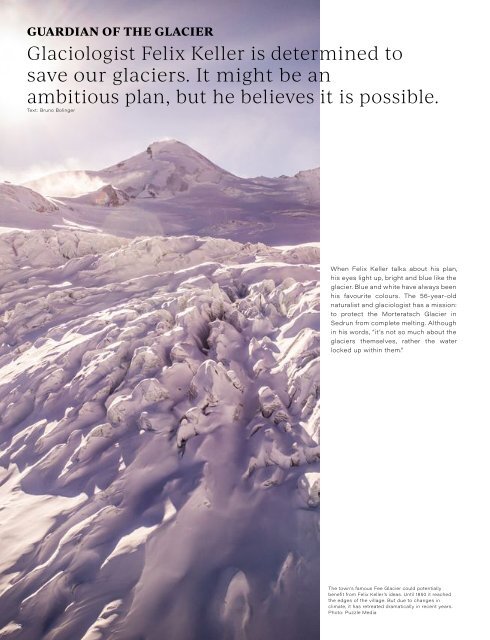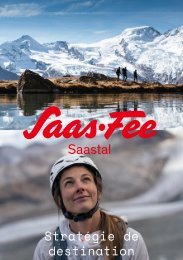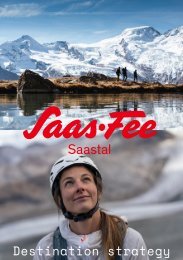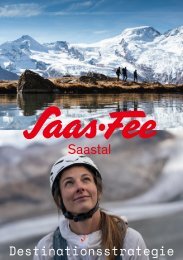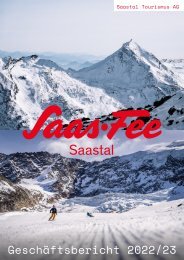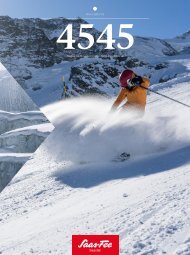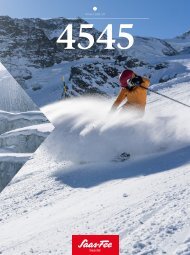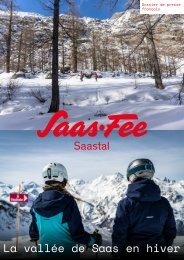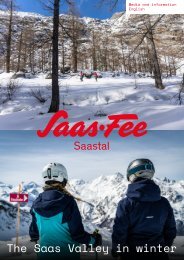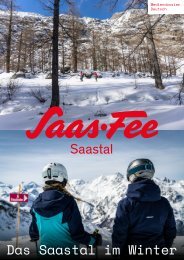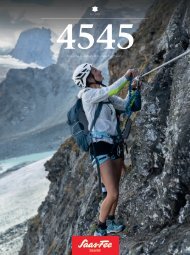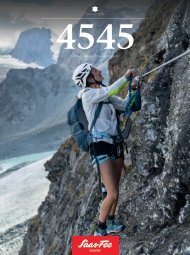You also want an ePaper? Increase the reach of your titles
YUMPU automatically turns print PDFs into web optimized ePapers that Google loves.
GUARDIAN OF THE GLACIER<br />
Glaciologist Felix Keller is determined to<br />
save our glaciers. It might be an<br />
ambitious plan, but he believes it is possible.<br />
Text: Bruno Bolinger<br />
When Felix Keller talks about his plan,<br />
his eyes light up, bright and blue like the<br />
glacier. Blue and white have always been<br />
his favourite colours. The 56-year-old<br />
naturalist and glaciologist has a mission:<br />
to protect the Morteratsch Glacier in<br />
Sedrun from complete melting. Although<br />
in his words, “it’s not so much about the<br />
glaciers themselves, rather the water<br />
locked up within them.”<br />
In Switzerland, 57 billion cubic metres of water are stored as ice<br />
in its glaciers. And that water is valuable. As the glaciers shrink,<br />
rivers will run lower and lower each year. At present, if the rains fail<br />
in summer, glacial melt prevents the rivers in the valley from drying<br />
up. But once the glaciers are gone, the water supply as we know it<br />
today will cease to function.<br />
Two years ago, Felix Keller was having lunch with his then<br />
supervisor at the Academia Engiadina educational institution in<br />
Samedan. “If you were of any value as a glaciologist, you ought<br />
to save the Morteratsch Glacier,” his supervisor teased. “Forget it,<br />
there’s no way that would work!” was Keller‘s answer at the time.<br />
But he couldn’t get the idea of saving the glacier out of his head.<br />
The very next day while fishing in a wild stream, he began to think<br />
through the possibilities and impossibilities of such an ambitious<br />
project. Glass, metal, plastic and paper – they all get recycled in<br />
this day and age, he thought. So why not the glacial meltwater?<br />
After days of thinking over the facts and turning them over in his<br />
head time and time again, Keller couldn’t find any good grounds<br />
on which to say they wouldn’t be able to successfully rescue the<br />
glacier. So the project was born. The question he found himself<br />
asking was: “Should we try to preserve glaciers as freshwater<br />
storage for future generations?”<br />
Keller presented his idea to friend and fellow glaciologist<br />
Hans Oerlemans from the University of Utrecht. A series of<br />
measurements taken by this university since 1994 makes the<br />
Morteratsch Glacier the world‘s best-studied glacier in terms of<br />
energy balance. Interestingly, Oerlemans, unlike Keller, believed<br />
the plan to be quite feasible. He suggested they could test the<br />
theory by spreading snow produced from the glacier’s meltwater<br />
over part of the glacier itself to protect it from solar radiation.<br />
The projections that followed the experiment were surprising.<br />
If just 10 percent of the glacier‘s surface could be kept snowcapped<br />
during the summer, the glacier would potentially start<br />
growing again within ten years. That would be a dramatic turnaround.<br />
But the numbers in question were enormous. One million<br />
square metres of glacier would have to be covered with metres of<br />
snow. That meant the project would require 30,000 tonnes of snow<br />
to be produced. 30,000 tonnes for each day of the short weather<br />
window between winter and early summer! It would need to be<br />
done in the high mountains and, if possible, without the use of<br />
electricity. Confronted with such a mammoth task, Keller faced<br />
sleepless nights once again.<br />
“If just 10 percent of the glacier’s<br />
surface could be kept snow-capped during the<br />
summer, the glacier would potentially start<br />
growing again within ten years.”<br />
Felix Keller, 56, grew up in Samedan and has three children. He is a co-director<br />
of the European Tourism Institute at the Higher School of Tourism in Samedan. He also<br />
works on various research projects and lectures on the geography of tourism,<br />
resource management, and teaching methods, and conducts international seminars.<br />
Photo: Bruno Bolinger<br />
A passionate violinist, Keller spends half an hour each morning<br />
practising. “My daily violin playing opens up my mind,” he says.<br />
Keller relies on his morning routine to come up with new ideas<br />
and solutions. One example is his plan to produce snow using a<br />
‘Schneelanze’ type snow cannon; it is patented in Switzerland and<br />
works without electricity. It should be possible to spread the snow<br />
using the cable cars that already run over the glacier. Soon, they<br />
hope that funding options will open up, and a working prototype for<br />
the project will be built in cooperation with industrial partners to<br />
prove its practical feasibility.<br />
The estimated cost of the whole project over the next 30<br />
years is 100 million Swiss francs. “That’s only a few million francs<br />
per year,” explains Keller, “even if it prevents just one river drying<br />
out in one of the dry summers we have to come, then it’s a good<br />
investment.” He goes one step further: “I recommend that we<br />
apply our approach to one glacier in each of the catchment areas<br />
supplying the six major rivers in Switzerland as soon as possible.”<br />
The town’s famous Fee Glacier could potentially<br />
benefit from Felix Keller‘s ideas. Until 1850 it reached<br />
the edges of the village. But due to changes in<br />
climate, it has retreated dramatically in recent years.<br />
Photo: Puzzle Media<br />
12<br />
13


